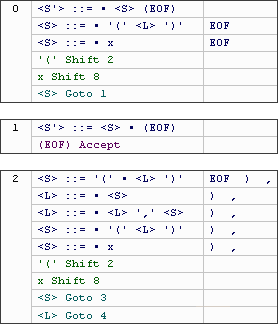 |
Parsing Concepts |  |
| Left-to-Right Derivation Parsing |
| Main | |
|
|
Latest News |
|
|
Getting Started |
|
|
Screen Shots |
|
|
Download |
|
|
Documentation |
|
|
Contributors |
|
|
Contact |
| About GOLD | |
|
|
How It Works |
|
|
FAQ |
|
|
Why Use GOLD? |
|
|
Comparison |
|
|
Revision History |
|
|
Freeware License |
|
|
More ... |
![]()
Introduction
The primary goal a parser is to organize a sequence of tokens based on the rules of a formal language. As the parser accepts a sequence of tokens, it determines, based on this information, when the grammar's respective rules are complete and verifies the syntactic correctness of the token sequence. The end result of the process is a "derivation" which represents the token sequence organized following the rules of the grammar.
Typically, Backus-Naur Form is used to define the context free grammar used by the language. The entire language, as a whole, is represented through a single nonterminal called the "start symbol". Often the parse information is stored into a tree, called a derivation tree, where the start symbol is the root node.
There are two distinct approaches currently used to implement parsers. Recursive Descent Parsers and LL parsers are examples of top-down parsers and LR parsers are examples of bottom-up parsers. Most parser generators, such as YACC, use one of the LR algorithm variants.
LR Parsing
LR Parsing, or Left-to-right Right-derivation parsing, uses tables to determine when a rule is complete and when additional tokens must be read from the source string. LR parsers identify substrings which can be reduced to nonterminals. Unlike recursive descent parsers, LR parsers do very little "thinking" at runtime. All decisions are based on the content of the parse tables.
LR parser generators construct these tables by analyzing the grammar and determining all the possible "states" the system can have when parsing. Each state represents a point in the parse process where a number of tokens have been read from the source string and rules are in different states of completion. Each production in a state of completion is called a "configuration" and each state corresponds to a configuration set. Each configuration contains a "cursor" which represents the point where the production is complete.
 LALR Parsing, or "Lookahead LR parsing", is a variant of LR Parsing which
most parser generators, such as YACC, implement. LR Parsing combines related
"configuration sets" thereby limiting the size of the parse tables. As a result,
the algorithm is slightly less powerful than LR Parsing but much more practical.
LALR Parsing, or "Lookahead LR parsing", is a variant of LR Parsing which
most parser generators, such as YACC, implement. LR Parsing combines related
"configuration sets" thereby limiting the size of the parse tables. As a result,
the algorithm is slightly less powerful than LR Parsing but much more practical.
Grammars that can be parsed by the LR algorithm, might not be able to be parsed by the LALR algorithm. However, this is very rarely the case and real-world examples are few. The number of states eliminated by choosing LALR over LR is sometimes huge. The C programming language, for instance, has over 10,000 LR states. LALR drops this number to around 350.
Typically, the LR / LALR parsing algorithms, like deterministic finite automata, are commonly represented by using a graph - albeit a more complex variant. For each token received from the scanner, the LR algorithm can take four different actions: Shift, Reduce, Accept and Goto.
For each state, the LR algorithm checks the next token on the input queue against all tokens that expected at that stage of the parse. If the token is expected, it is "shifted". This action represents moving the cursor past the current token. The token is removed form the input queue and pushed onto the parse stack.
A reduce is performed when a rule is complete and ready to be replaced by the single nonterminal it represents. Essentially, the tokens that are part of the rule's handle - the right-hand side of the definition - are popped from the parse stack and replaced by the rule's nonterminal plus additional information including the current state in the LR state machine.
When a rule is reduced, the algorithm jumps to (gotos) the appropriate state representing the reduced nonterminal. This simulates the shifting of a nonterminal in the LR state machine.
Finally, when the start symbol itself is reduced, the input is both complete and correct. At this point, parsing terminates.
For more information, please refer to the following:
- Loudan, Kenneth C. (1997). Compiler Construction, PWS Publishing Company, 20 Park Plaza, Boston, MA 02116-4324
- Appel, Andrew W. (1998). Modern Compiler Implementation in C. Cambridge University Press, 40 West 20th Street, New York City, New York 10011-4211
- Fischer, Charles N. & LeBlanc Jr., Richard J. (1988). Crafting a Compiler, The Benjamin/Cummings Publishing Company Inc., 2727 Sand Hill Road, Menlo Park, California 94025
- ... or just search for "LALR Parsing" on the Internet.